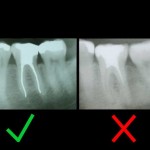Our topic in the next weeks is root canal treatment and its risks! (9/10)
In the last few reports you read about root treatment, root tip resection and the attendant risks.
Introduction to root canal treatment
Why is treatment performed on a root canal?
What happens during a root canal?
Pain after a root canal – is that normal?
What are the costs of a root canal?
Can you renew or redo a root canal?
Risks of a root canal – cyst?
Risks of a root canal – root tip resection?
Today we would like to show you a few x-rays, which are all numbered, and in the next report you will find out how to tell good root treatments from bad
 We are positive that after this series of reports, you will even be able to tell whether your root canal was treated properly or not, based on x-rays.
We are positive that after this series of reports, you will even be able to tell whether your root canal was treated properly or not, based on x-rays.
–
And you have a right to do so!
–








